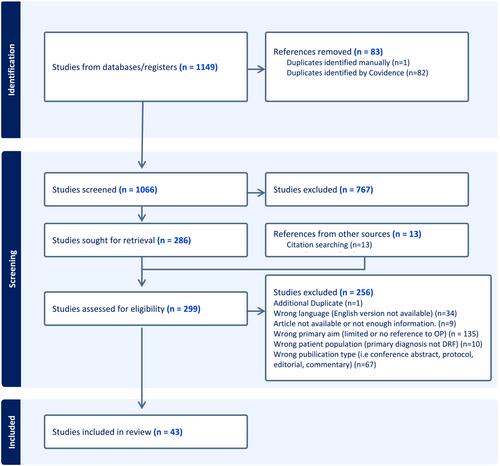Distal radius fracture (DRF) is one of the most common upper extremity fractures treated by hand therapists and can lead to chronic physical impairment and reduced occupational performance. This scoping review aimed to reveal what is currently known about occupational performance following DRF and to explore if and how occupational performance is defined and considered in the research.
This review was guided by the PRISMA-Scoping review and the Joanna Briggs Institute (JBI) guidelines. Relevant databases were searched, and studies that addressed occupation performance in adult participants following DRF were included. The findings were summarised according to the components of occupational performance (person, occupation, and environment), and quality was measured using the Mixed Methods Appraisal Tool.
Forty-three articles met the eligibility criteria for inclusion. All of the studies discussed at least two components of occupational performance, while 25 recognised all three. The consideration of occupational performance was dominated by biomechanical issues associated with the person component (i.e. range of motion, strength). There was some acknowledgement of the psychosocial aspects of the person and, to a lesser extent, the environment, as well as the impact of both on return to occupational performance.
Despite occupational performance being at the core of occupational therapy theory, its consideration within the context of research on DRF appears to be focussed on the person component of occupational performance and on biomechanical issues. Further research is recommended to determine how much this reflects current clinical practice and if a more comprehensive consideration of occupational performance will improve rates of recovery following DRF.
As part of the protocol development for this review, consumers and stakeholders were consulted. They provided feedback on clarity and importance of the research questions.
A distal radius fracture happens when you break the bone on the thumb side of your wrist. This type of injury often occurs when you fall and land on an outstretched hand. It is one of the more common injuries that hand therapists see in their practice. For some people, recovering from this fracture can take a long time and come with a lot of pain, difficulty moving, and emotional stress. These problems can make it hard to do everyday things like driving, cooking, or getting dressed. It can also affect both paid and unpaid work as well as leisure and social activities, making life more difficult for everyone involved.
The findings from this review suggest that the current research usually focuses on how the body physically heals from this type of injury, but it does not pay as much attention to the emotional and social impact on healing. Also, it does not always discuss the activities that are important to the person, or the environment where they live, work, and socialise. This may show a gap in the research regarding our full comprehension of recovery from distal radius fractures. Taking a broader view and approach to recovery, considering a person's emotions, social life, environment, and daily activities, could help people recover fully and get back to their previous life routines and roles after this type of injury.


